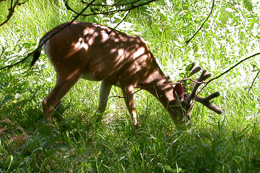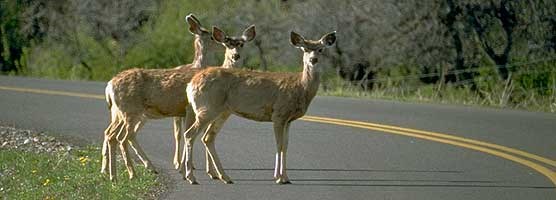From the Yosemite National Park Daily report:
“WHEN BUMPERS MEET ANTLERS: Big brown furry beasts sometimes emerge from the wilderness to cross a public road. Unfortunately, no one taught them to look both ways first. Too often, the result is a motorist’s nightmare;
collision with a deer. The animal usually comes out second best in this type of close encounter, but the toll on vehicles and their occupants can also be substantial. Each year, about 700,000 animal vehicle collisions cause about $1.2 million in damage, the insurance information institute estimates. While animal-vehicle collisions can happen any time of year, fall is the peak season for deer-car accidents.
No foolproof way has been found to keep deer off highways and away from vehicles.
Deer whistles have their advocates, but the Insurance Institute for Highway Safety says there’s no scientific proof to support claims they prevent deer from approaching cars or reduce crash risk.
You can avoid an unplanned meeting with a deer. Here’s how:
* Be aware of your surroundings, Pay attention to ‘deer crossing’ signs. Look well down the road and far off to each side. At night, use your high-beam lights when possible to illuminate the road’s edges. Be especially watchful in areas near woods and water. If you see one deer, there may be several others nearby.
* Be particularly alert at dusk and dawn, when these animals venture out to feed.
* If you see a deer, on or near the roadway and think you have time to avoid hitting it, reduce your speed, tap your brakes to warn other drivers, and sound your horn. Deer tend to fixate on headlights, so flashing them may cause the animal to move. If there’s no vehicle close behind you, brake hard.
* If a collision seems inevitable, don’t swerve to avoid the animal; your risk of injury may be greater if you do. Hit it, but control the vehicle. Report the accident to the police.
* Always obey the speed limit and wear safety belts.”
______________________________________________
If you do collide with a deer, or any other animal, don’t get out of the car to look at it unless you are certain it is dead. If it is just stunned you could be in danger.
Be sure to pull off the roadway and park carefully.
______________________________________________
In 2010, vehicles in Grand Teton park hit and killed two wolves, five bears, 6 pronghorn, 17 bison, five moose, 41 deer and 48 elk. Most of the deaths occured between dawn and dusk on the main highway between Moose and Moran Junctions. Please drive the speed limit and be prepared to stop suddenly. Speed was the biggest factor, especially at night when people “overdrive their high beams – when stopping distance is greater than the headlight illumination distance.” Driving slower than the posted speed limit, especially after dark, can save animal (and human) lives.
______________________________________________
Also from the Yosemite Daily report:
“The Wawona Safety Team offers the following driving tips from the website of The Humane Society of the United States:
Be Alert!
Be especially watchful for wildlife at dawn, dusk, and in the first few hours after darkness falls. Many species of wildlife are most active at these times.
Edges of roads that border agricultural fields or natural habitats are places to be particularly watchful for wildlife.
Assume that animals do not know to get out of your way. Young animals, in particular, do not recognize cars as a threat.
Lower your dashboard lights slightly. You’ll be more likely to see your headlights reflected in the eyes of animals in time to brake.
Every apple core, french fry, and smelly sandwich wrapper tossed out of a car attracts wildlife to roadsides—often with fatal results. Never throw litter from your car.
Remember that where there is one animal crossing, there may be more, young animals following their mother or male animals pursuing a mate.
Try to slow down, especially after dark. Many animals needlessly become victims simply because people drive too fast to avoid hitting them. Speed poses a risk to human safety as well.
(D.Shenk/Wawona District Safety
Action Team – 12/07/04)
______________________________________________
And from an AAA website https://exchange.aaa.com/safety/driving-advice/tips-to-avoid-animal-vehicle-collisions/:
“Tips to Avoid Animal-Vehicle Collisions
Animal-vehicle collisions are not only costly, but can be dangerous. From 2001 to 2011, animal collisions contributed to more than 2,080 fatal crashes nationwide. Whether a deer, dog, moose or squirrel, animals on the roadway are unexpected, and their actions can be erratic and unpredictable, creating a dangerous situation for motorists. AAA encourages drivers to use caution and remain alert to avoid becoming involved in a collision with wildlife.
Most wildlife-vehicle collisions occur during the fall and winter, and many are preventable.
What To Do If An Animal Runs In Front Of Your Vehicle
Scan the road and shoulders ahead of you. Looking ahead helps provide enough reaction time if an animal is spotted. Also, remember some animals move in groups, so when there is one, there are usually more in the area.
Use high-beam headlights if there’s no oncoming traffic. Wildlife may be spotted sooner when using high beams. This will give the driver time to slow down, move over or honk the horn to scare the animal away. High beams also help in spotting some animals’ reflective eyes.
If a collision is unavoidable, apply the brakes firmly and remain in your lane. Swerving to avoid an animal can often cause a more serious crash or result in drivers losing control of vehicles.
Be extra cautious at dawn and dusk. Most animals, especially deer, tend to be more active early in the morning and at dusk.
Slow down and use extra caution when traveling through areas with a high and active wildlife population. Be aware of increased wildlife movement in some regions during certain times of year, such as hunting or mating season.
Drivers should always wear a seat belt and remain awake, alert and sober.”
_________________________________________________________________
You might also want to read Safe driving in rain and fog,
and/or Snow chain rentals.
_________________________________________________________________
![]()
Top reasons not to speed in a National Park has defensive driving advice.
____________________________________________________________________
Road trip advice and etiquette has practical advice from experienced and newbie carpoolers on cross country trips, including ways to keep from being so bored; planning before the trip; safety issues; drowsy driving; packing; road trip games, storytelling, debates and discussions; links to gas price watch sites, and how to deal with windows that are fogging up faster than your navigator can wipe it off.
We advise people to check everything that powers, stops, cools, heats, ventilates and lights their vehicle before they leave on an adventure. Road trip vehicle prep and recommended service has checklists (including many things people can do without a mechanic).
Read about safety at wildlife jams
See also info on determining safe distances from wildlife, with charts and photos to better be able to determine and visualize how far away from wildlife you need to stay to be safe (and obey laws that do have penalties). The people in the photos below are too close to the wild animals:


______________________________________________
From the Yosemite Daily report of 10/20/03
“Memorandum
To: All Employees, Yosemite National Park
From: Superintendent, Yosemite National Park
Subject: Visitors and Deer Hazards
The opportunity to observe wildlife at close range is a vacation highlight for many visitors to Yosemite. Unfortunately, some visitors carry this experience too far by getting dangerously close to the wildlife, which places both them and the animals at risk.
This is especially true with the mule deer that frequent developed areas in Yosemite Valley.
Visitors need to be made aware that even though the deer may appear ” tame,” they are wild animals that can inflict serious injuries. The only wildlife-related fatality in Yosemite’s history occurred when a young boy was gored while feeding a mule deer buck.
The risk of similar incidents is especially high in the fall, because this is rutting season, when bucks become more aggressive as they compete for females. However, the danger also exists with does, which are also capable of injuring people with their hooves. The number of deer in developed areas also tends to increase in the fall, as they seek fallen acorns. This further increases the chance of human-deer conflicts.
I’m sending you this message because we have had frequent deer sightings near the Park Administration building and in the Mall area. Visitors have also been approaching these animals too closely. If you notice visitors doing this, please stop and take a moment to courteously explain the dangers involved.
/s/Michael J. Tollefson”
See also deer hazards, including information about injuries from deer, deer hazards, baby deer by themselves are not abandoned.

The author of this webpage, (written as a homework reading assignment for my students), does not give any warranty, expressed or implied, nor assume any legal liability or responsibility for the accuracy, completeness, or usefulness of any information, product, or process included in this website or at websites linked to or from it. Users of information from this website assume all liability arising from such use.
